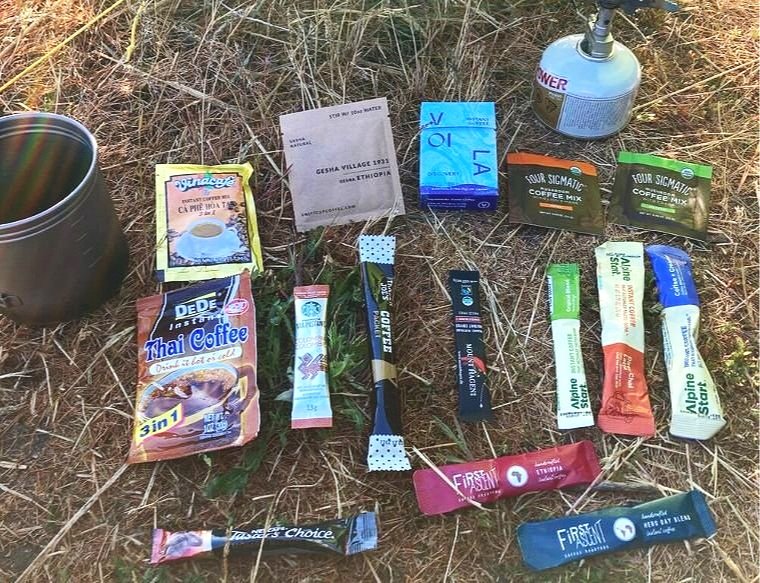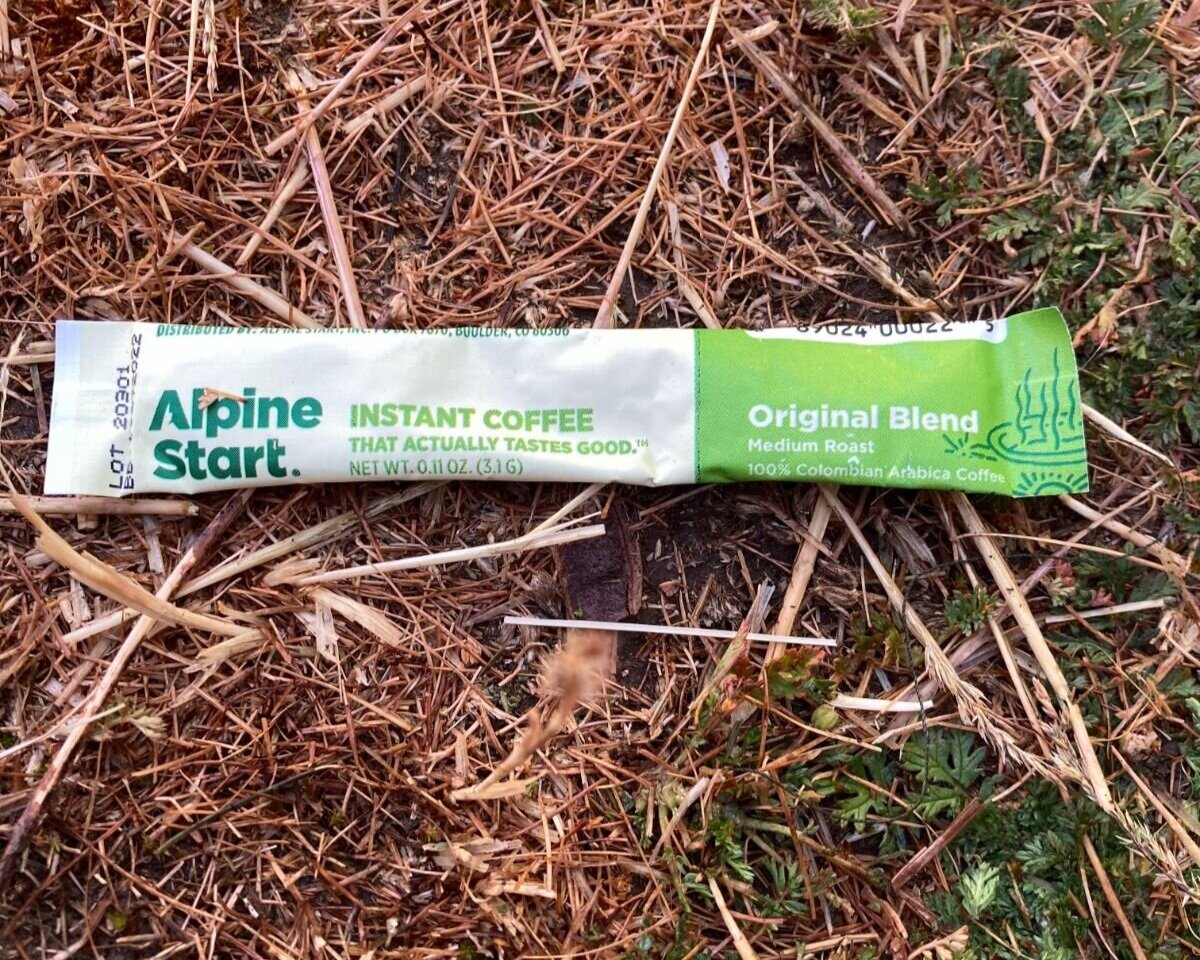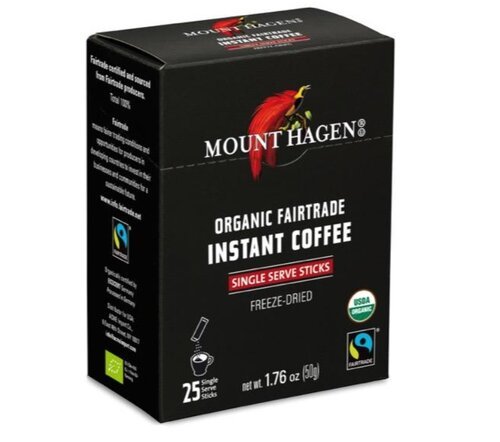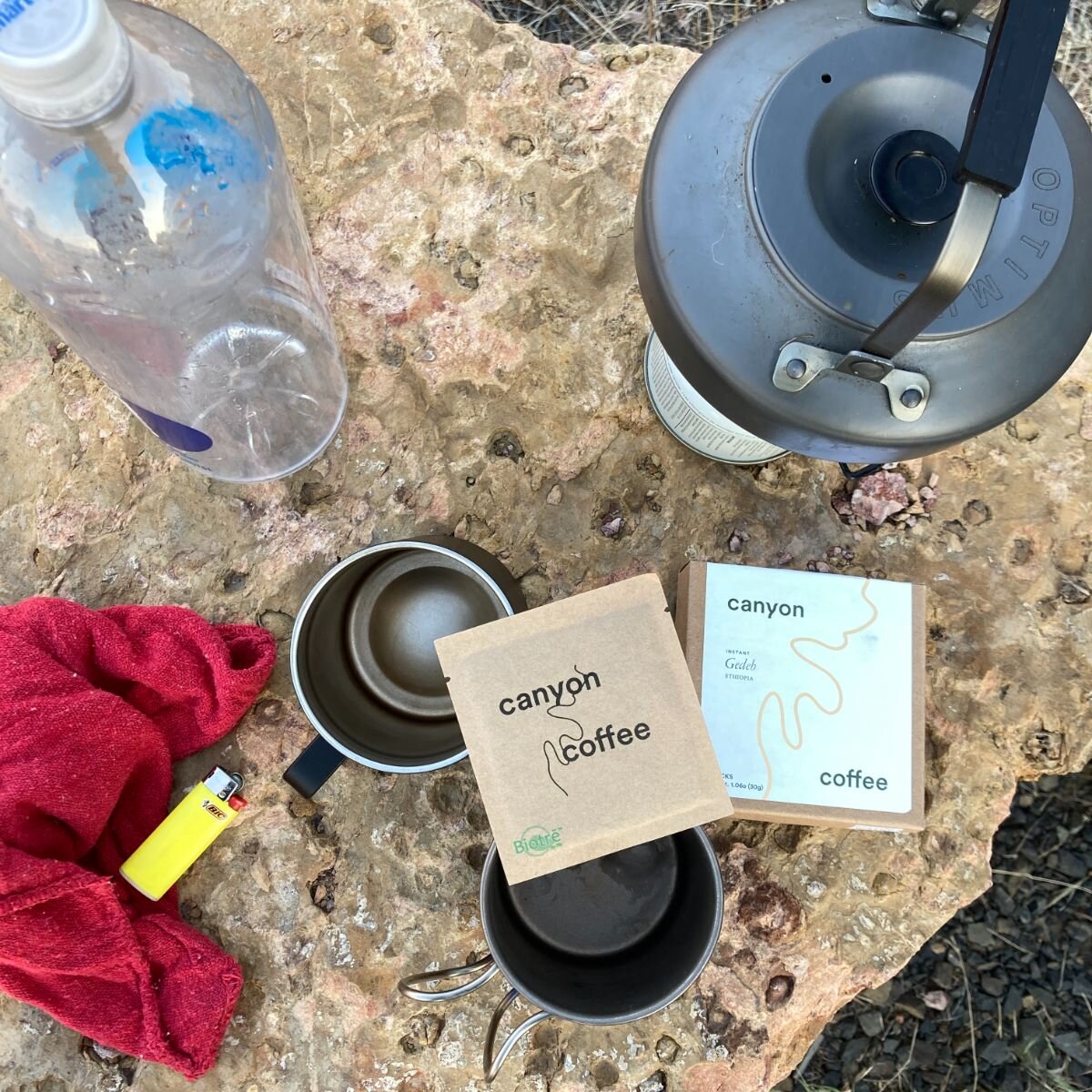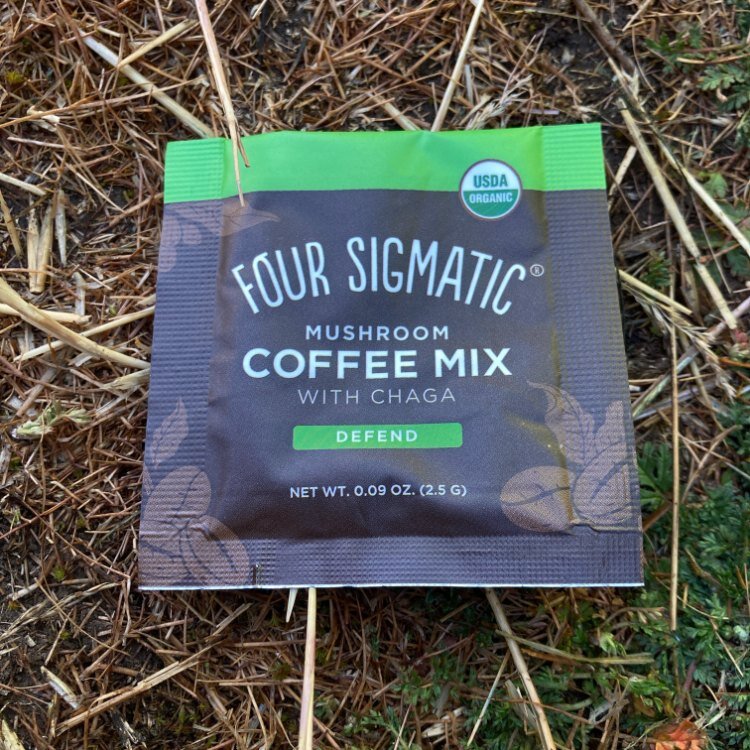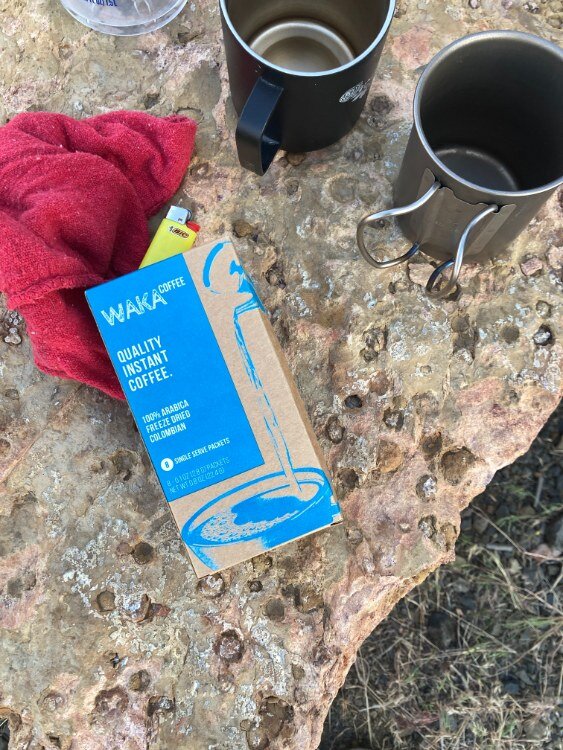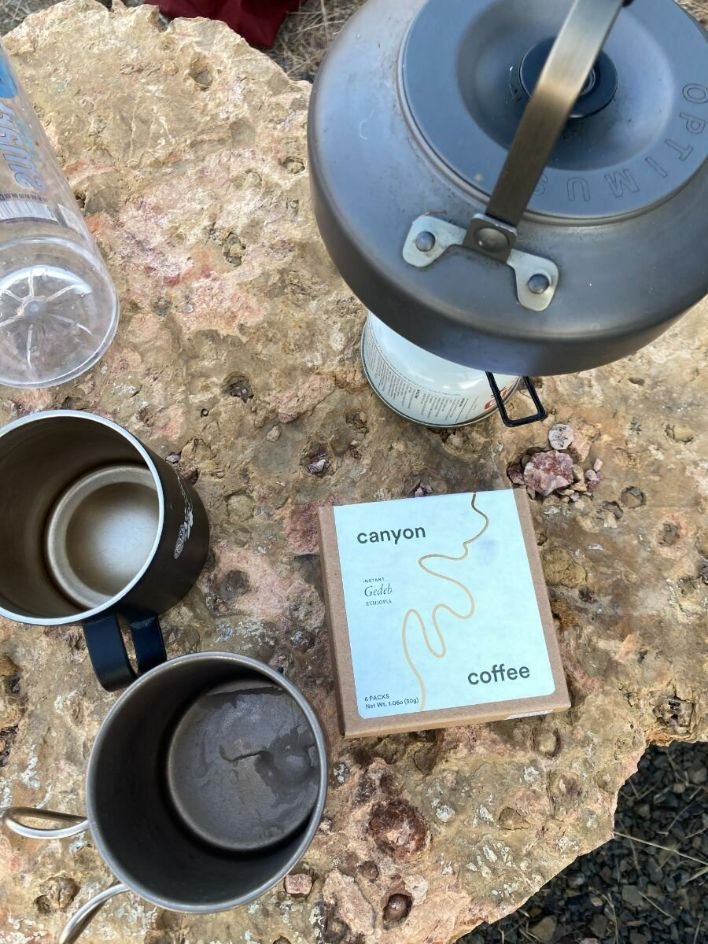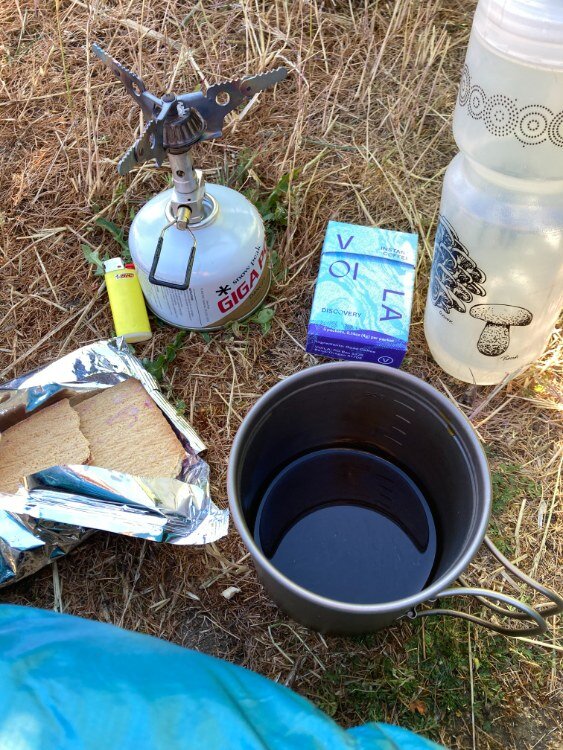Best Instant Coffee for Camping of 2024
Best-Tasting Caffeinated and Decaf Instant Coffee for the Outdoors: camping, backpacking, bikepacking, thru-hiking
Home > Gear Reviews > Backpacking
May 29th, 2024, updated with several new coffees we tasted including a new specialty coffee winner.
There’s nothing better than a freshly brewed cup of coffee made with high-quality coffee beans. But getting your coffee fix in the outdoors can be complicated. Instant coffee makes that process easier and more lightweight. Our taste-testers compared 24 instant coffees to find the best instant coffee for camping, backpacking, thru-hiking, and bikepacking.
Coming from the specialty coffee world, I looked for high-quality coffee that had the caffeine content to which I’d become accustomed.
In the past 5 years, the influx of instant coffees has opened up options for just about every way you’d take your coffee (minus the luxury of frozen blended frappes). It’s also much easier to find plain instants that are enjoyable to drink even without additives like milk powder, as new options have focused on eliminating the bitterness I used to associate with instant coffee.
There are plenty of backcountry coffee options out there—from bulk instant to steeped (where you would soak a packet of coffee grounds like a bag of tea), hand-ground regular coffee to pre-ground disposable coffee pour-overs—but we stuck to single-serve instant coffee packets for their ease of brewing and minimal amount of waste to pack out.
We tested 24 different instant coffees ranging from black coffee to coffee with cream and sugar to give you a better idea of what’s on the market—and help you find the quality instant coffee of your dreams.
Related: Best Camping Coffee Makers
We create reader-supported, objective gear reviews independently selected by our editors. This story may contain affiliate links, which help fund our website. When you click on the links to purchase gear, we may get a commission, without costing you an extra cent. Thank you for supporting our work and mission of outdoor coverage for every body! Learn more.
Instant Coffee Comparison Table
| INSTANT COFFEE | OUR AWARD | PRICE PER SERVING | ROAST | SOURCE | ORGANIC? | FAIR/EQUAL TRADE? | FREEZE-DRIED | RATING | CAFFEINE (MG) | PACKAGING |
|---|---|---|---|---|---|---|---|---|---|---|
| Alpine Start Original Blend | Best Overall Read why |
$1.25 | Medium | Columbia | N | N | Y | 3 | 121 | Plastic hard-sided vial |
| Mount Hagen Single Serve Packet | Best Budget Read why |
$0.48 | Medium | Mount Hagen, Papua New Guinea | Y | Fair Trade | Y | 3 | 158 | Mylar waterproof packet |
| Vinacafe 3 in 1 Ca Phe Hoa Tan | Best with Creamer Read why |
$0.28 | Medium / Dark | Buon Me Thuot, Vietnam | N | N | Not available | 3 | Not available | Mylar waterproof packet |
| Verve Instant Craft Coffee | Best Specialty Read why |
$2.67 | Medium | Antigua and Cauca, Colombia and Honduras, Latin America | N | N | Y | 4 | Not available | Not stated |
| Canyon Instant Coffee | $3.34 | Light-medium | Ethiopia | N | N | Y | 4 | Not available | Not stated |
The Best Instant Coffee
The Overall Best Instant Coffee: Alpine Start Original Blend
Rating (1-5): 3
Caffeine Content: 121mg
Price per Serving: $1.25
Organic: No
Fair Trade/Equal Trade: Yes (not certified)
Roast: Medium
Packaging: Plastic hardsided vial
What we liked: Best value of taste and cost, good options, easy to find
What we didn’t like: Not organic or Free Trade
After testing 22 different instant coffees, Alpine Start Original Instant Coffee Blend was my favorite instant coffee. At $1.25 per packet (read: cup), it’s the best value when considering both the taste and the cost.
Compare Prices Of The Alpine Start Original Blend
Alpine Start took the prize for Best Overall Instant Coffee because it has everything we’re looking for in an instant coffee: balanced taste, mixed well in the field, is reasonably priced, and widely available. Photo by Graham Hodge.
The Alpine Start Original Blend made a smooth and well-balanced cup of coffee. As soon as I finished my first cup, I found myself wanting a second just to keep the goodness flowing. While I didn’t have any notes of chocolate or fruit splashing over my palette, it wasn’t too bitter or astringent, even when I accidentally diluted it too much. It also mixed easily and left little to no residue in the bottom of my cup.
If you’re not into plain coffee, Alpine Start has three alternatives for you. The first two are an instant latte (coffee + creamer) and an instant dirty chai latte—though those will run you about $2.00 per packet ($10 per box of 5). I think they’re worth the extra spend (especially if you’re vegan or lactose intolerant, as the creamer used is non-dairy)—but if you’re looking to go lightweight, know that these packets are about double the size and weight of the Original Blend packets.
We love that Alpine Start is easy to find online with bulk ordering options—both in individual packets and larger quantities if you’re looking to reduce your environmental footprint. However, I’ve also noticed that REIs tend to have all of Alpine Start’s offerings in-store if you’re grabbing last-minute supplies. It’s also available in a 30-serving jar for those on extended trips or for reducing waste when sharing with a group.
The Best Budget Instant Coffee: Mount Hagen Organic Instant Coffee
Rating (1-5): 3
Caffeine Content: 158mg
Price per Serving: $0.48
Organic: Yes
Fair Trade/Equal Trade: Yes
Roast: Medium
Packaging: Mylar waterproof packet
What we liked: Organic, Fair Trade, good price
What we didn’t like: Generic instant coffee flavor
The Mount Hagen was the best instant coffee I tried from all the coffees I found at general grocery stores. While it was surprisingly way tastier than the Nescafe and Starbucks (see reviews below), I found that it still had the generic instant coffee flavor (or lack thereof) found in freeze dried instant coffee. Still, given the price, that it is organic, fair trade, and its widespread availability, it’s a good option when you need quality budget coffee or don’t have access to specialty stores.
Compare Prices Of The Mount Hagen Organic Instant Coffee
Mount Hagan took the prize for Best Budget Instant Coffee because of its smooth mouthfeel, easy mixing, and wide availability. Even without buying it in bulk, Mount Hagan is one of the most affordable instant coffees we considered—and it’s organic and fair trade! Photo by Graham Hodge.
What made Mount Hagan instant better than the others for me was how balanced it was. It didn’t come across as overly bitter and didn’t leave my mouth feeling dry. It does have a hint of dark chocolate as far as flavor notes go, but imagine 85% dark chocolate. It also mixes well in hot water, which works well for backcountry use.
While not as great as some of the specialty instant coffees on the market, we chose the Mount Hagen Single Serve Coffee as our overall grocery store winner due to its smoothness in mouthfeel (not too bitter or acidic), wide availability online and in grocery stores, and its affordability. And best of all, it’s organic and fair trade!
The Best Instant Coffee With Creamer: Vietnamese Instant Coffee VinaCafe
Rating (1-5): 3
Caffeine Content: Not stated
Price per Serving: $0.28
Roast: Medium / Dark
Organic: No
Fair Trade/Equal Trade: No
Packaging: Mylar waterproof packet
What we liked: Sweet and smooth, good deal
What we didn’t like: May contain lactose, even in “non-dairy” options
I tested VinaCafe, which is very sweet and smooth to drink. If you can’t find this specific instant coffee brand, or the very similar DeDe Instant, you may be able to find similar coffees available in a pack of about 40 packets of 3-in-1 (coffee, sweetener, and creamer) for about $10-13 per pack. Having that much instant coffee at once always seemed excessive to me, but if you like to stock up, send yourself resupply boxes, or just drink a lot of instant coffee, then at $0.30-$0.48 a packet, it’s a great deal.
Compare prices of the Vincafe
Coffees that include sugar and creamer can taste weak or taste underpowered. DeDe Instant and VinaCafe took the prize for Best Budget 3-in-1 Instant Coffee because they pack a lot of flavor at a reasonable price. Photo by Graham Hodge.
A note for the lactose-avoidant: while some of the advertising I found on the bulk packages of Vietnamese instant coffee stated that they used non-dairy creamers, the long list of ingredients included “milk protein.” So be sure to check ingredient lists to make sure your instant coffee is right for you.
Are you looking for another budget instant coffee that may not have so many ingredients (including no sugar or creamer)? Mount Hagen’s 25-packet boxes were around $10, making solid instant coffee for about $0.48 a packet. The Mount Hagen was a bit bitter and roasty-tasting but had a smooth finish that didn’t leave me reaching for water afterward. If you’re looking for even cheaper options, the Starbucks Via and Nescafe (reviewed below) were the cheapest instant coffee packets without additives.
The Best Specialty Splurge Instant Coffee: Verve Instant Craft Coffee
Rating (1-5): 4
Caffeine Content: Not available
Price per Serving: $2.67
Roast: Medium
Organic: No
Fair Trade/Equal Trade: No
Packaging: Not stated
What we liked: Great taste
What we didn’t like: Expensive
“Specialty coffee,” at its essence, revolves around the quality of the coffee beans in your cup. Specialty coffee roasters purchase higher-quality beans from farmers who grow, harvest, sort, and process the beans such that there are minimal defects.
Verve coffee is a specialty coffee roasters that has created an instant that is unique-tasting, yet easily packaged for taking into the backcountry. Unlike other brands, its instant coffee isn’t a powder. We taste-tested their Variety Pack. Of the six coffees included, the Street Level Craft was bright and fruity with an crema foam on top that is rarely found in instant.
View the Verve Instant Craft Coffee
The Verve instant coffee had a crema that is rare in instant coffee.
Once a specialty coffee roaster has freshly sourced “green” beans, they then need to be roasted. The roasting process is a delicate process where the roaster uses heat to bring out the naturally occurring flavors in the beans while trying not to burn them. Dark roast beans are roasted longer and brought closer to burning than light roast beans.
Since some flavor and caffeine are lost the longer a coffee bean is roasted, many specialty coffee roasters choose a light to medium roast for most of their coffee options, as we found in Verve’s instant craft coffee. The result is an instant coffee where the flavor can actually come out like you’d find in a real cup of coffee.
Unlike other instant coffee, Verve instant coffee has coffee flakes instead of a powder.
Although Verve instant coffee is more expensive than other instant coffees we tasted, the flavors were notable. It didn’t taste like instant. We liked that they had a variety pack so you can compare coffees from different countries of origin and roasts. Though, as noted above, the Street Level is their original award-winning blend with notes of apple and honeycomb.
We've recommended several specialty instant coffees over the years that have come and gone and appreciate that unlike other speciality instant coffee, Verve's supply chain seems more reliable.
This isn’t the cheapest cup of instant out there—but if you’re looking for a cup of coffee in the backcountry or while traveling that can hold its own against any cup of drip from a specialty coffee shop, then look no further.
Other Coffees We Reviewed
Canyon Instant Coffee
Rating (1-5): 4
Caffeine Content: Info not available
Price per Serving: $3.33
Organic: Yes
A lot of specialty coffee roasters have started producing their own instant coffee options. All the ones I’ve tried have been impressive: they’re well-balanced and feature easily discernible tasting notes.
When I tried the (now discontinued) Gesha by Swift Cup, I was stoked to try such a rare and valuable coffee in the form of instant coffee.
Like Voila, Swift Cup takes some fantastic specialty coffees and makes them instant. Gesha Coffees tend to be difficult to grow due to their unique cultivation practices, but the beans they produce are known for their exotic flavor profiles. Gesha coffee beans have historically sold for about $130 per pound, making Swift Cup’s $3 to 5 per packet price seem a little more understandable.
VIEW THE CANYON INSTANT COFFEE
Canyon Coffee Instant Ethiopian was among the best instant coffees we tasted. However, given its price, it’s best enjoyed by true coffee enthusiasts who don’t mind spending extra for an extraordinary cup in the backcountry. Photo by Graham Hodge.
There were nice notes of berry fruits and dark cocoa which don’t often come across in instant coffee.
Of course, it’s not the most cost-effective instant coffee. We think if you’re looking for specialty instant coffee, the Verve is a better value. But if price isn’t a factor and you’re on a higher-quality “specialty” instant coffee kick, I’d recommend picking up a box.
Nescafe instant coffee has a cult following among those who associate it with international trips, where Nescafe may be the most prevalent coffee available. But unless you have fond memories of Nescafe, we suggest spending a little more for a better budget cup of instant coffee. Photo by Graham Hodge.
Nescafe House Blend
Rating (1-5): 1
Caffeine Content: 12.25mg per fl oz
Price per Serving: $0.29
Organic: No
Nescafe’s instant coffee is the cheapest per packet instant coffee I tried at $0.29 per packet!
That being said, I felt like I got what I paid for.
The Nescafe is a rough cup of coffee to get down, and while it would increase the price per cup, I would likely blend it with some hot cocoa or creamer if I wanted to drink a lot of it for several days in a row.
Nescafe was bitter all the way through the sip and left my mouth both dry and puckered at the same time—not how I want to start or finish a cup. If you’re not a picky coffee drinker and just want caffeine for as cheap as possible, then Nescafe House Blend Instant Coffee might be for you.
Compare Prices Of The Nescafe House Blend
First Ascent instant coffee has a balanced taste and smooth feel without a bad aftertaste. Photo by Graham Hodge.
First Ascent Hero Blend and Ethiopia
Rating (1-5): 3, 4 (respectively)
Caffeine Content: Info not available
Price per Serving: $2.50
Organic: No
Packaging: Mylar waterproof packet
First Ascent has been popping up more and more as an instant coffee brand name these days—and for good reason too! Their instant coffee is consistently better than what you’d typically find at the store. It has a balanced taste and smooth feel, and while I didn’t notice any bold flavor notes, it also didn’t leave a bad aftertaste (I’m looking at you, Nescafe).
Like most of the non-additive coffees, First Ascent mixed thoroughly and left little to no instant residue at the bottom of the cup. The Ethiopia option has a lighter profile than the Hero Blend, which has more of a roasty profile.
View The First Ascent Instant Coffee
Trader Joe’s instant coffee is a 3-in-1 mix that includes cream and sugar. They don’t have quite the same pick-me-up that other instants do but have a smooth and enjoyable flavor. Photo by Graham Hodge.
Rating (1-5): 2
Caffeine Content: Info not available
Price per Serving: $0.62
Organic: N
I first discovered Trader Joe’s instant coffee mix in a hiker box on my thru-hike of the Pacific Crest Trail. They changed my morning routine for the rest of my hike—and I even had my mom visit a Trader Joe’s and mail me more!
These 3-in-1 packets of cream, sugar, and coffee are a smooth and excellent treat for the trail. I don’t think these are quite as sweet as the Vietnamese instant coffees, and the ratio of the ingredients used make for an even cup of coffee.
However, I tend to make two of these at a time with about 14 ounces of water for a better cup since I’ve noticed these don’t give me the pick-me-up that some of the other instants do. The Trader Joe’s packets also dissolve really well, particularly for a mix that includes cream and sugar.
View The Trader Joe'S Instant Coffee Mix
Starbucks Via has among the highest caffeine contents of any of the instant coffees we tried. Photo by Graham Hodge.
Rating (1-5): 2
Caffeine Content: 130-140mg
Price per Serving: $0.94
Organic: No
While I know many folks love Starbucks Via, they come across almost as rough as the Nescafe to me.
I tend to dilute them a bit more (or mix them with hot cocoa) to smooth them out and make them more bearable.
While Via’s bitterness knocks it off the list for me, it does pack quite the caffeine punch! They mix well and are an easy-to-find option if you’re picking up a last-minute pack on your way to the trailhead. Starbucks also offers an instant decaf coffee version.
Compare Prices Of The Starbucks Via Instant Coffee
Four Sigmatic Organic Cofee includes chaga, reishi, lion’s mane, or other mushroom blends for added health benefits. However, we found that the mushroom flavor could clash with coffee. Instead, we recommend their latte mixes, which mellow the flavor. Photo by Graham Hodge.
Rating (1-5): 2
Caffeine Content: 50mg
Price per Serving: $2.00
Organic: Yes
There’s been a lot of hype around Four Sigmatic Organic Coffee. I first heard about them on Tim Ferriss’ podcast, but they may have just been a sponsor. Unfortunately, I find them the most challenging of all the instant coffees I've tested to drink.
I am a massive fan of mushrooms and enjoy the boasted benefits of lion’s mane, chaga, and reishi—I even forage for my own during the fall. But I found that the umami flavors mixed with coffee made for a tough cup of instant coffee to swallow; the mushrooms’ earthy flavor only made the instant coffee bitterness more difficult to handle.
That said, I now carry Four Sigmatic’s coffee-free instant Golden Milk Latte mix on every overnight trip. It’s made with Turkey Tail mushrooms, turmeric, black pepper, and coconut milk powder. So if you’re looking for something warm to drink that tastes great, has no caffeine, and is good for your digestive tract, then I would recommend trying it instead of the coffee mixes.
Compare Prices Of The Four Sigmatic Organic Coffee
Waka coffee has a rich flavor best enjoyed with a creamer. We like their Give Water Initiative to support clean drinking water. Photo by Graham Hodge.
Rating (1-5): 2
Caffeine Content: 70mg
Price per Serving: $1.25
Organic: No
Roast: Dark
Waka’s instant coffee reminded me of the flavor profile of Mount Hagen’s Single Serve Packet.
The crystals mixed well into a cup of coffee with rich flavor, but I wanted some oat milk or creamer to add to it. While much better than similarly priced instant coffees, I found it had a darker roast profile and bitter finish. I tried their medium roast Colombian because it is the most popular, but may have enjoyed their light roast more.
Waka has many purchasing options — convenient single-serve packets as well as 80-serving bulk bags for a fraction of the price. They also have instant decaf coffee options.
I loved Waka’s Give Water Initiative, where 4% of their profits go towards providing clean drinking to over 26 different countries! If you don’t care about what instant coffee you’re drinking and want part of your purchase to go to a good cause, then I couldn’t think of a better option to purchase.
Compare Prices Of The Waka Instant Coffee
Cascadia Instant mixes well in hot and cold water, making it ideal for summer trips. We recommend mixing Cascadia Coffee with 10-12 ounces of water (about 2-4 ounces more than recommended on the package). Photo by Graham Hodge.
Rating (1-5): 3
Caffeine Content: 300mg
Price per Serving: $2.67
Organic: Y
Cascadia Coffee offers a healthy number of options for your instant coffee fix.
I thoroughly enjoyed their decaf coffee, which is a tasty option if you’re looking to cut back on caffeine.
Cascadia’s instant is a bit more flavorful than your typical Folgers packet but it lacks complexity and tastes about how you’d imagine instant coffee would taste. Cascadia recommends using 8 ounces of water for each pack. However, I found that to be way too strong for my preference—about 10 to 12 ounces hit the spot for me. Their instants mix easily and do well when shaken up in cold water to cool down on hot days.
View The Cascadia Coffee
Why use instant coffee while camping, backpacking, and bikepacking?
Brewing Canyon Coffee’s instant on a bikepacking trip. Canyon Coffee is a specialty coffee roaster that can now be enjoyed while far in the backcountry. Photo by Graham Hodge.
Getting a good cup of coffee in the backcountry has gotten much easier with the proliferation of instant coffee brands.
Getting a good cup of coffee while camping can be easier if you don’t mind the weight of a camping coffee maker or are camping close to a vehicle.
But while I used to carry all sorts of brewing equipment into the backcountry, the extra weight of the coffee equipment can be a dealbreaker. In fact, Treeline Review writer Sam Schild wrote about his camping coffeemaker for that reason in What I wouldn’t carry on the PCT again.
I’ve gone to lengths to avoid that extra coffee gear weight myself. For example, I tried to give up caffeine while section-hiking the Pacific Crest Trail —which lasted about five days. As a compromise—and it was a compromise—I started trying every kind of instant coffee I could find.
At the time, the best instant coffees were bulky packets full of flavoring, creamers, and lots of sugar. I was hiking so much and burning so many calories that none of the additives bothered me.
On shorter trips, like bikepacking trips aimed at less than 24-hours, the additives do bother me. Luckily, there are many brands that make instant coffee without additives to get as close as possible to the joys of backcountry coffee made with a coffee maker.
A compilation of the instant coffees that we taste tested for this guide. Photo by Graham Hodge.
Buying advice
Price
The instant coffees I tried ranged from $0.15 to $5 per packet. I found that the quality became consistently solid once the price averaged about $1.00 per packet. The quality became even better at about $2.00 or so per pack. While the very high-end coffees were interesting, I didn’t think they were worth the $5 a cup price tag—especially when an average 12-ounce cup of really good plain coffee in Portland is about $3 or so.
Gesha Village 1931 by Swift Cup Coffee was among the best instant coffees we tasted. This specialty cup is the most expensive we tested, though. It’s best enjoyed by true coffee enthusiasts who don’t mind spending extra for an extraordinary cup in the backcountry. Photo by Graham Hodge.
Profile
A coffee’s profile can include the taste, texture, and aroma a coffee gives off. A good cup of instant should check all of these boxes for you!
The best coffee profile for you is the one you fall asleep thinking about how excited you are to drink it in the morning—and that might be different for different people, so taste around to see what works for you.
We get more into understanding coffee flavor in the next section below.
Cream and Sweetener
Regardless of how good plain instant coffee is getting these days, you may still like to take your coffee with cream and sugar—and that’s alright! We all hike our own and hike and drink our own coffee. The wonderful thing is that numerous instant coffee options include sweeteners and creamers.
One surprise about instant coffee creamers: a lot of them are non-dairy! Most of the non-dairy options we saw were coconut-based. The Vietnamese instant coffees hit an excellent price point, but the Alpine Start Dirty Chai Latte and Coffee + Creamer were my absolute favorites.
However, if you’re a die-hard dairy fan, I’d highly recommend Trader Joe’s 3-in-1 instant coffee—if you have access to a Trader Joe’s. The Trader Joe’s 3-in-1 was my go-to on the PCT, and it’s what I frequently come back to for a well-rounded cup at an affordable price.
Ease of Mixing
While instant coffee may look like very finely ground coffee beans, it is, in fact, already-brewed coffee (so yes, it’s real coffee)! The coffee powder we’re used to is liquid coffee that’s dried out using one of two different methods: spray-drying or freeze-drying. It’s important that these granules mix easily and leave little to no residue in the bottom of your cup.
PACKAGING
While it didn’t make or break our choice, you may want to consider instant coffee’s packaging. For example, if you’re headed on a rafting trip or camping or backpacking trip in the rain, paper packaging may not adequately protect your instant coffee. Similarly, if you are an ultralight gear enthusiast, plastic vials that protect some instant coffee may be too heavy or bulky. Some packaging is recyclable. Decide what is important to you and plan for your trips and coffee accordingly.
How I Tested the Instant Coffees
I tested coffee using the specialty coffee cupping protocols. I also tested them on various bikepacking trips in the Pacific Northwest. Photo by Graham Hodge.
Through my work in the specialty coffee industry, I’ve led many cupping events over the years. Cupping is a technique for tasting coffee used by coffee producers and buyers to evaluate a coffee’s quality. Essentially, all you do is gently slurp a coffee and consider aspects such as mouthfeel (dry or watery), acidity (bitter or astringent), sweetness (sweet or savoury), and flavor notes (chocolate, fruits, etc...).
For example, I once cupped a coffee from Ethiopia that was smooth in the sense that it was not astringent or bitter and did not leave a dry, mouth-smacking aftertaste. On top of the smoothness, the tasting notes included bold blueberries and graham crackers. While I’m no sommelier, these tasting notes were pretty universally experienced among the other tasters.
Cupping for detail is great, but I wanted to look for more practical points of evaluation in the world of instant coffee. I mainly looked for balance, body, taste, and dilution. While I made sure all of the instant coffees I tested were packed in individual packages for ease of use and packing, brands like Alpine Start offered bulk containers that could easily be repackaged for less waste and easier cleanup.
Voila Instant Coffee won our award for Best Speciality Splurge Instant Coffee. It’s well-balanced with discernible tasting notes, which is rare in instant coffee. Photo by Graham Hodge.
Balance
The balance of each coffee included the acidity and mouthfeel of the coffee. Think of a well-balanced cup of coffee like the gradual rise of a roller coaster or a bell curve. It should have a gentle increase of coffee flavor from the initial sip, with a smooth flavor in the middle and a soft, easy finish.
If you find the sip finishes with a sour note, it might mean that the coffee is too astringent or diluted—which means you might be able to add a little more instant coffee to balance it out. If the finish was dry or bitter, then the coffee might need some more water added to it to balance it out.
Compared to at-home brewing, using instant makes it easier to balance out your cup since there are only two variables to control: the coffee and the water. With some of the instant coffees I tested, no amount of playing with ratios could cure the off-balance taste and mouthfeel.
BodY
The body of the coffee plays into how balanced it is but has more to do with flavor and mouthfeel. Think of the body of a coffee as the peak of flavor during a sip, particularly on the back of the tongue as you start to swallow—that’s when you really taste what a coffee has to offer. Bitterness and sourness are essential here, as well as the overall texture or tactile feeling of the coffee when you’ve taken a big slurp.
Compared to café coffee, instant coffee might be more watery or bolder when considering the body. Some of the instant coffees that I felt were too watery at the recommended ratio of coffee to water became silty when I tried using less water—and, notably, they were usually the instants that included creamer and sweetener. To tweak this for yourself, start with less water and add more to taste.
Taste
Taste was vital for me. The slightly more expensive specialty instant coffee packets I tested had discernable tasting notes—“flavors” that don’t involve any additives—which I’m sure reflects these instant coffees’ creation process and use of higher quality beans. However, I didn’t want to focus exclusively on these coffees since everyone’s palate is different, and we all have varied taste preferences when it comes to coffee. That being said, I noticed the specialty coffees were generally more balanced, had consistently better bodies, and mixed very well with hot water.
Dilution
Dilution, or how well the instant coffee crystals mix with water, is also crucial to getting a solid instant coffee experience—and sometimes it depends on whether you’re drinking it hot or cold. I found some instant coffees, like Starbucks Via, mixed okay with cold water but often left many coffee granules at the bottom of the bottle or cup. Hot water made for much easier mixing. That being said, the instant coffees that included creamer and sweetener required vigorous stirring. On the other hand, the plain coffee crystals mixed evenly—often just by using the packaging itself as a stir stick—with little to no leftover crystals at the bottom of the cup.
What is Instant Coffee? Is Instant Coffee the same as Ground Coffee?
Instant coffee may look like finely ground coffee beans, but is actually spray-dried or freeze-dried pre-brewed coffee. Photo by Graham Hodge.
While instant coffee may look like very finely ground coffee beans, it is, in fact, already-brewed coffee (so yes, it’s real coffee)! The coffee powder we’re used to is liquid coffee that’s dried out using one of two different methods: spray-drying or freeze-drying. Both processes involve using concentrated coffee that’s brewed too strong (and bitter) to drink itself.
Spray Drying Process
The brewed coffee concentrate is sprayed into very hot air in the spray-drying process—approximately 480 degrees Fahrenheit—where it almost instantaneously dries out, leaving coffee crystals behind.
Freeze Drying Process
Freeze-drying involves a few more steps. First, the brewed coffee concentrate is usually set over a heat source until some of the water evaporates out. Next, this thicker coffee extract is then chilled, where it becomes an even more viscous substance. Finally, this cold coffee goop is frozen and put into a vacuum chamber with no air, where any frozen liquid evaporates—leaving behind coffee powder.
Neither freeze-dried nor spray-dried instant coffee is going to give you the rich flavor of a freshly brewed cup. Supposedly, freeze dried coffee retains more of the coffee’s original flavor notes, but figuring out what method each producer uses can get complicated. Higher-end options sometimes use “proprietary” (read: secret) processes that are intended to preserve as much of the original coffee tasting notes as possible—and I’m not quite sure how they’re made. (I do know, however, that high-end options source higher quality beans that are brewed within two to four weeks of roasting, when the beans have the best flavor profiles.)
Related: Best Food Dehydrator
Which instant coffee has the most caffeine?
When enjoying instant coffee on a camping trip, many folks wonder which instant coffee has the most caffeine. Photo by Graham Hodge.
If you drink coffee, you likely began drinking it for the caffeine. I love the ritual, flavors, and warmth of coffee, but caffeine is why I bring coffee into the backcountry.
I typically drink lighter roast coffees at home, which tend to have more caffeine (about 110 milligrams) than darker roasts (95 milligrams on average). So I was pretty shocked to learn that instant coffee has less caffeine—at about 30-50 milligrams less, on average—than a light roast cup of regular coffee. So if you already have a good tolerance for caffeine and are active during the day, you may find yourself craving an additional cup. I remember one backpacking trip where I’d wake up and savor a cup of instant every morning before packing up camp. I always found myself justifying a second cup on our first break of the day—and even more often if it was chilly out!
Of the 22 coffees we tested, the Cascadia Coffee Mountain Sunrise has the most reported caffeine at 300 mg per cup. The Four Sigmatic has the least caffeine at 50 mg per cup.
Out of all the instant coffees I tried, I found that the ones with non-dairy creamer, regardless of sweetener content, gave me more energy that stuck with me longer. While this could be a personal metabolism effect—I’m no nutritionist—this might have something to do with the fat content of the milk alternative creamer. The Starbucks Via was one of the only single-origin packets that didn’t include any additives, such as cream or sugar, that met my caffeine needs after just one cup.
What is the best instant coffee to water ratio?
All instant coffee packages have suggestions on how much hot water to add per packet. However, you may find your desired flavor profile uses more or less hot water than the instructions. Photo by Graham Hodge.
Almost all of the instant coffee I tried had a recommended water volume amount of 8 to 12 ounces per packet. If you’re home-brewing instant, you’ll likely have a way of measuring out the exact water amount—and I’d try to get as close to the recommendation as possible. While some camping mugs or pots have measurements on them that’ll get you close, I’ll tell you the best trick I’ve found for making quality instant coffee in the backcountry:
Pour a little hot water into your cup first, which keeps the coffee crystals from sticking to the bottom. Use LESS water than you think you’ll need.
Add the packet’s contents and stir.
Then, after tasting, you can dilute it as much as you want, which helps you get the flavor you’re looking for!
How Can I Learn More About Coffee?
I recommend you start your coffee learning at your local coffee shop. They’ll likely be a great source of coffee knowledge, as they have the pulse of the industry. In addition, many coffee shops host numerous coffee-related events, and if they roast their own coffee beans they may even host public or private cupping events where you can learn to profile and evaluate coffees.
Another place to get to know more about coffee is Sprudge. There are plenty of sites about coffee out there, but I have always gone to Sprudge for its thorough reviews about coffee and coffee shops, coffee industry news, and the latest information on coffee.
If you’re more into reading, check out God In A Cup: The Obsessive Quest for the Perfect Coffee by journalist Michaele Weissman (Amazon). Weissman explores coffee growers’ and brewers’ passions for coffee and dives into all aspects of the market, including the highly sought-after Gesha coffees that sometimes sell for $130 a pound (or more)!
If you’re more focused on brewing at home, I would recommend Brew by Brian W. Jones (Amazon). It’ll not only look great in your kitchen but includes a ton of valuable information and recipes for brewing coffee in all sorts of ways!
About The Author / Why You Should Trust Us
I’ve been working in the outdoor industry for the past eight years. I’m also a coffee lover. I got my start climbing competitively in college and backpacking for fun. I section hiked the PCT in 2016—my first foray into long-distance backpacking—while working with brands such as Leki, Osprey, and Nemo Equipment. In addition, I’ve worked as a photojournalist for publications such as Rock and Ice and Roots Rated. I started bikepacking in 2017, and I’ve continued to work with many outdoor companies since then.
In between outdoor industry assignments, I worked as a barista at several specialty coffee shops. I was eventually recruited to help open a coffee shop and train a team of new baristas in every aspect of brewing and serving coffee. As a result, fresh coffee has followed me into the backcountry in many different forms.
I used to lug my aero-press along on trips, but as the instant coffee market expanded, I realized there were better—and less bitter—options than the instant coffee of days past. So whether you’re a self-proclaimed coffee lover or just looking for something tasty, this piece is for you.

